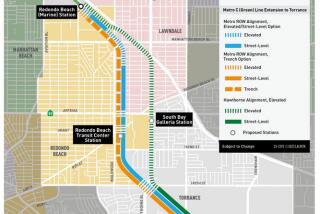Other Cities Overestimated Rail Ridership
- Share via
ORANGE — Transit officials overestimated urban rail ridership in San Francisco, Portland, Ore., and other locations because of inaccurate assumptions about job growth, the availability of shuttle buses and service convenience, a new report concludes.
Prepared by the Orange County Transportation Authority and released this week, the study of West Coast urban rail systems was ordered by the OCTA board three months ago. The study’s purpose is to prevent OCTA from making similar mistakes in planning an elevated, urban rail line that would initially link Irvine and Anaheim with several stops in between.
Currently, the $2-billion to $3-billion rail link is undergoing engineering and feasibility studies. But money is short and the project probably won’t be built until the end of the decade.
The ridership forecast issue arose because of a recent federal study that showed most urban rail systems fall far short of expectations.
However, transit officials in Los Angeles and San Diego counties accurately predicted ridership on the Long Beach-Los Angeles Blue Line and the San Diego Trolley system, respectively, the OCTA report states.
The survey of ridership forecasts was conducted by OCTA rail planner Nancy Michali, who came to the agency this year from the Los Angeles Metropolitan Transportation Authority. Her report will go before the OCTA board at its Monday meeting.
The accuracy problem, Michali wrote, occurs because projections and rail projects change over time. Rail systems rarely open or operate as planned. But accuracy improves as original estimates are revised during construction.
“It is important to recognize that Orange County is in the early stages of its study of urban rail,” Michali warned. “Ridership projections prepared (now) will be different than the opening day ridership.”
The OCTA report recommends that the agency base its ridership projections on “conservative population, employment, and other modeling factors” as well as a “continuation of existing regional patterns.”
The San Francisco Bay Area Rapid Transit system’s initial ridership projections were far too high, according to the OCTA study, partly because the first estimates were developed 11 years before the system was actually constructed. In addition, BART opened with only 71.5 miles instead of the projected 120 miles.
In addition, BART planners “originally assumed more commuters would walk to the stations and that only 25% of the riders would be driving,” Michali wrote. “Automobile access turned out to be a more important factor than anticipated.”
In Portland, the city’s Tri-Met system projected too many rail passengers because the city lost 34,000 jobs between 1980 and 1985, the OCTA report states. Rail planners had assumed there would be job growth and residential growth.
Bus feeder service also was inadequate because funding wasn’t available. The same problem occurred with the number of rail cars. Now the system is approaching maximum ridership capacity, but that’s because the size and convenience of the system has been financially constrained.
On the other hand, projections for the Blue Line and the San Diego trolley were close to actual ridership because forecasts were conservative, assumed a flat economy and were based on system funding that planners knew in advance that they could obtain, the report says.
More to Read
Sign up for Essential California
The most important California stories and recommendations in your inbox every morning.
You may occasionally receive promotional content from the Los Angeles Times.













